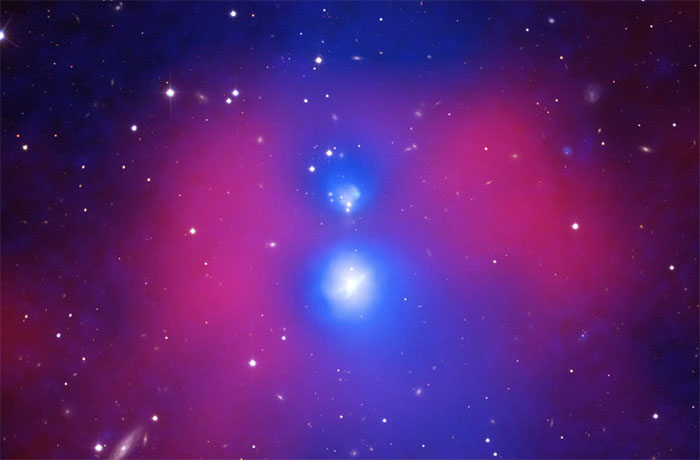The two groups of galaxies are 100 trillion times the mass of the Sun
The scientists observed two groups of galaxies rushing at each other at 4.6 million kilometers per hour, preparing to form a large cluster.
Most galaxies do not exist in isolation. Instead, gravity pulls them together into small groups or clusters with hundreds of thousands of members. Sometimes, these sets continue to be pulled back by gravity, collide and merge.

NGC 6338 may be the most violent collision and merger between two galaxy groups.(Photo: NASA).
With data from NASA's Chandra X-ray Observatory, the European Space Agency's XMM-Newton spacecraft (ESA), the Metrewave Giant Radio Telescope in India and the Apache Point Observatory in the US, The researchers found that two groups of galaxies were rushing at each other at a speed of about 6.4 million kilometers per hour. This is probably the most violent collision between two galactic groups ever observed, IB Times reported on 17/12 reported.
Two groups of galaxies, collectively known as NGC 6338, are about 380 million light-years from Earth and have a total mass of about 100 trillion times that of the Sun. Studying NGC 6338 can help astronomers better understand the evolution and development of galaxy clusters.
The team estimates that 83% of NGC 6338 is dark matter, 16% is hot gas and only 1% is a star. This suggests that the two galaxy groups will become a giant cluster in the future. Once merged, it will continue to attract other galaxies thanks to gravity.
This is not the first study of NGC 6338. According to previous studies, around the center of two groups of galaxies are regions of low-temperature gas that emit X-rays called "cold cores". This information helps astronomers reconstruct the shape of NGC 6338.
New data from Chandra and XMM-Newton shows that some of the gas regions of the cold cores seem to be subjected to shock waves from the collision. Computer models used to predict this phenomenon. However, this is the first time scientists have been able to observe in detail the phenomenon of gas being heated during a galaxy merger. This will cause a certain amount of hot gas to not cool to create new stars.
Another common source of heat in galactic groups and clusters is the energy emitted by the high-speed stream of particles emitted by supermassive black holes. However, scientists do not see signs of these particles in NGC 6338.
- Detecting a bright group of galaxies more than 3 trillion times the Sun
- How many galaxies in the universe?
- Detecting the minimum mass of the galaxy
- Detecting the galaxy seems to not exist
- The brightest galaxy in the universe is evaporating
- The Milky Way is lighter than we thought
- 4 galaxy clusters collide 3 billion light-years from Earth
- Korean scientists first discovered medium mass black holes
- Cosmic vibrations reduce the mass of galaxies
- The brightest galaxy in the universe
- The Fairy Galaxy will not
- The mystery of the dead galaxies
 'Fine laughs' - Scary and painful torture in ancient times
'Fine laughs' - Scary and painful torture in ancient times The sequence of numbers 142857 of the Egyptian pyramids is known as the strangest number in the world - Why?
The sequence of numbers 142857 of the Egyptian pyramids is known as the strangest number in the world - Why? History of the iron
History of the iron What is alum?
What is alum? Decoding Vietnamese genes: Who are we?
Decoding Vietnamese genes: Who are we?  The world's first complicated 'bird society'
The world's first complicated 'bird society'  Why men love war?
Why men love war?  USD 750,000 from NASA for anyone who finds a way to turn CO2 on Mars into other molecules
USD 750,000 from NASA for anyone who finds a way to turn CO2 on Mars into other molecules  The origin of the first farmer group in Europe
The origin of the first farmer group in Europe  Ancient men kill 'enemy love'
Ancient men kill 'enemy love' 